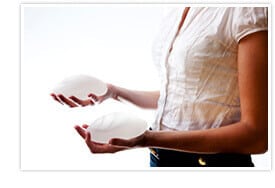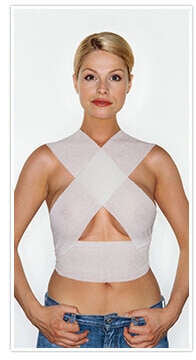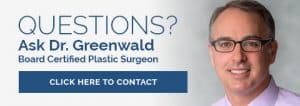Breast Augmentation

Breast Implants & Augmentation in Westchester County & NYC
Serving Patients in Putnam county, White Plains, Yonkers, New Rochelle, & Mount Vernon
- Why Choose Dr. Greenwald?
- Overview of Breast Augmentation
- Who Is a Suitable Candidate?
- Saline vs. Silicone Breast Implants
- “Gummy Bear” Breast Implants
- Breast Implants Placement Options
- Incision Approaches
- How to Choose Breast Implants
- Recovering From Breast Augmentation Surgery
- What Does It Cost?
- How Long Do Breast Implants Last?
- Does It Matter Where And By Whom I Have My Surgery Performed?
- When Do I Know If My Breasts Have Stopped Growing?
- What Expectations Should I Have If I Decide To Have Breast Augmentation Surgery?
- What If My Breasts Are Two Different Sizes Or Shapes?
- What Can I Do To Prepare For My Consultation With Dr. Greenwald?
- What Will My Recovery After Breast Augmentation Be Like?
Why Choose Dr. Greenwald?

Dr. Greenwald’s Awards and Memberships
Joshua A. Greenwald, MD, FACS, is a board-certified New York plastic surgeon. Breast augmentation surgery is not a simple procedure, and your result depends on the experience and skill of your surgeon. Each patient is different and requires a unique procedure to achieve optimal results. Dr. Greenwald has significant experience in breast implant surgery, and performs hundreds of primary and revision breast augmentations yearly. He offers a choice of breast implant types, incisions and placement options. Most patients have minimal or no pain, minimal or no bruising, and a prompt return to normal activities. There are no drains and, typically, no sutures to remove.

Dr. Greenwald is proud to have been selected to the Mentor® LEAD Program Advisory Board in 2012 and 2013. Mentor Corporation is one of the leading manufacturers of breast implants in the United States, and each year Mentor invites a select group of plastic surgeons to discuss new products, programs and innovations in breast augmentation surgery. Dr. Greenwald is now using Allergan breast implants as he feels Allergan currently has the most comprehensive line of breast implants available. Dr. Greenwald has been selected as a Top Doc by Westchester Magazine and a Top Doctor by Castle & Connolly every year since 2012.
Dr. Greenwald performs his surgeries at the state-of-the-art Surgical Specialty Center of Westchester. He helped design this facility from the ground up. The facility meets and often exceeds hospital safety standards. Anesthesia is provided by board-certified anesthesiologists, and all of the nursing staff has significant experience caring for plastic surgery patients.
Overview of Breast Augmentation
At the New York practice of Joshua A. Greenwald, MD, FACS, many women request augmentation mammoplasty, or breast augmentation surgery, with saline or silicone breast implants to enhance their breast profile. Dr. Greenwald performs breast augmentation surgery for patients who would like to:
- Increase their breast cup size
- Improve the appearance of sagging breasts that look flattened or deflated (often due to major weight loss or pregnancy/breastfeeding).
- Improve undesirable shape or contour of their breasts
- Improve breast asymmetry
Who Is a Suitable Candidate?
Only a board-certified plastic surgeon such as Dr. Greenwald is qualified to determine if someone is an appropriate candidate for breast augmentation. Nevertheless, in general, suitable breast augmentation candidates include those who:
- Desire larger or fuller breasts
- Desire a greater degree of cleavage or of outward projection from the chest wall
- Desire breasts that appear higher up on the chest wall
- On the whole, have a positive self-image, but are frustrated with certain aspects of their breasts
- Are in good physical and mental health overall
- Have sensible expectations for the outcome of breast augmentation surgery, and are seeking aesthetic improvement — not necessarily perfection
- Are pursuing breast augmentation of their own volition
- Are not breastfeeding (Women who are currently nursing should wait 12 weeks after they have stopped breastfeeding to undergo breast surgery, so their true breast size can be established.)
Video: What to Expect from Breast Augmentation with Dr. Greenwald
Hear about the breast augmentation experience at Dr. Greenwald’s practice from one of his many satisfied NYC breast augmentation patients.
Saline vs. Silicone Breast Implants

Dr. Greenwald offers his breast enhancement patients saline and silicone breast implants.
Saline breast implants have a silicone outer shell but are filled with saline solution, or sterile saltwater.
The main benefits of saline implants are that:
- Dr. Greenwald can use smaller incisions with saline implants (than he would with silicone implants) because they are filled after they are inserted into the implant pocket.
- The body can safely absorb the saline filling material in case the implant ruptures.
The principal drawbacks of saline implants are that:
- They do not resemble the look and feel of natural breast tissue as closely as silicone implants do.
- They are more prone to folding or wrinkling in the implant pocket.
- They may be visible under the surface of the skin, especially in women with thin skin or little body fat.
In contrast, silicone breast implants have both a silicone outer shell and a silicone-gel filling.The greatest advantage of silicone implants is that they more closely look and feel like natural breasts than their saline counterparts. MemoryGel® breast implants are composed of an outer silicone shell and filled with a cohesive gel formulation that acts as a solid rather than a liquid, and holds together uniformly. Numerous studies have demonstrated the safety of silicone implants.
The principal disadvantages of silicone implants are that:
- They arrive from the manufacturer pre-filled, so the Manhattan breast augmentation surgeon must use slightly larger incisions through which to insert them.
- Patients with silicone implants are at risk of “silent rupture,” a condition in which the breast implant has ruptured, but the patient is not aware of it because the body cannot absorb silicone, causing the filling material to remain intact inside the implant pocket.
Because of the risk of silent rupture, the FDA recommends that women with silicone breast implants undergo a breast imaging exam such as an MRI or mammogram every three years, starting the third year after the initial breast enhancement procedure.
Silicone Implants
Allergan manufactures three main types of silicone gel implants: Natrelle Inspira Responsive, Natrelle Inspira Soft Touch, and Natrelle Inspira Cohesive. All of these implants are made of cohesive silicone gel (not liquid silicone!). The Natrelle implants are smooth round implants that are available in various sizes and projections. Dr. Greenwald prefers cohesive silicone gel implants in cosmetic breast surgery for their more natural feel. All of Natrelle implants are “gummy bear implants”. In September 2024, the FDA approved Motiva® silicone breast implants for use in the United States. This is the latest FDA-approved silicone breast implant since 2017. Dr. Greenwald has been one of the early adopters of Motiva implants. To learn more about Motiva implants, click here.
Summary of differences between saline and silicone
| Saline | Silicone | |
| Incision length | Approximately 2.5 cm | Approximately 3.5 to 4 cm |
| Outer shell | Silicone | Silicone |
| Implant Fill | Saline | Silicone |
| Implant Surface | Smooth and textured surfaces available. Dr. Greenwald places all implants in a submuscular pocket and uses primarily smooth implants. | Smooth and textured surfaces available. Dr. Greenwald places all implants in a submuscular pocket and uses primarily smooth implants. |
| Risk of “rippling” | Rippling more common than with silicone implants especially in very thin patients | Less rippling than with saline implants |
| Feel | Soft particularly in patients that are not very thin. In thin patients, may feel firmer and ripple more than silicone implants. | Soft and more natural feeling than with saline implants. Consistency more like breast tissue. |
| Average implant lifespan | Implants are made to last a lifetime and are warrantied by the implant company for life. Patients are told there is .5% chance per year of having an implant-related issue. | Implants are made to last a lifetime and are warrantied by the implant company for life. Patients are told there is .5% chance per year of having an implant-related issue. |
| Rupture | Easy to detect | Harder to detect |
| Harder to detect | Cost less than silicone | Costs slightly more than saline implants |
Breast Implants Placement Options
Dr. Greenwald offers two breast implant placement options: subglandular and submuscular.
With submuscular placement, Dr. Greenwald positions breast implants under the pectoral, or chest, muscle. Dr. Greenwald places more than 95 percent of his implants in the submuscular position. A lower incidence of capsular contracture, the ability to obtain high-quality mammograms and a more natural look are some of the reasons he prefers the submuscular position over the subglandular position.
With subglandular placement, Dr. Greenwald positions the breast implants under the glandular, or breast, tissue. However, subglandular placement may not be a suitable option for women with thin skin or little body fat because, in this case, the implant might be visible under the skin.
Incision Approaches

Dr. Greenwald offers three incision approaches: inframammary (crease incision), periareolar and transaxillary.
The inframammary approach – Dr. Greenwald makes the inframammary incision in or near the breast’s natural crease. This incision is easily concealed by the overlying breast and is rarely visible during normal activities. The inframammary approach allows for the precise creation of the implant pocket and the cleanest entry for the implant. It is associated with the lowest incidence of capsular contracture and the lowest incidence of sensory changes of the nipple-areola complex.
The periareolar approach – With this incision option, the breast plastic surgeon creates an incision around the outer perimeter of the areola (the darkly pigmented skin encircling the nipple). The periareolar incision is perhaps the least visible in properly selected patients because it is concealed by the darker skin of the areola. The incision can be reused if the patient requires revision surgery for bleeding or capsular contracture. It is the preferred approach if a mastopexy (breast lift) is needed. It has similar rates of capsular contracture to other incisions and a comparable rate of decreased nipple sensation.
The transaxillary approach – With this approach, Dr. Greenwald positions the incision required for breast augmentation in the armpit area. He utilizes an endoscope, or lighted camera, to help tunnel through the fat that is found under the skin (i.e., subcutaneous fat), creating an implant pocket behind the breast tissue. He typically uses this incision approach to insert unfilled saline implants. One of the drawbacks of this is incision is the increased incidence of implant malposition (i.e., lateral displacement of the implant pocket). If breast lift is also required, it cannot be done through an axillary approach.
How to Choose Breast Implants
Aside from choosing the size and type of breast implants, the implant placement method and the incision approach, breast augmentation patients must also choose the shape and texture of breast implants. Dr. Greenwald prefers smooth round implants. The different profiles (i.e., moderate, moderate plus and high profile) available will be discussed during your consultation.
During your consultation, Dr. Greenwald will review the patient’s unique anatomy and aesthetic desires, and will help her decide on a suitable surgical treatment protocol that will best meet all her needs. This includes making decisions about the size, shape and texture of breast implants as well as the incision approach and placement method.
Dr. Greenwald will review before-and-after photos of breast augmentation surgery patients with you during your consultation to help educate you on sizing and expectations. He also utilizes the Mentor® Volume Sizing System to help you determine what size implants will work best for you. This will help you get an excellent idea of what your new breasts will look like.
Recovering from Surgery
Video: Breast Augmentation Recovery
Learn more about the expected breast augmentation recovery time after breast implants surgery in New York City with Dr. Greenwald.
Before breast augmentation surgery, patients receive comprehensive pre- and post-surgical care instructions. Following breast augmentation surgery with Dr. Greenwald:
- Most patients are able to resume normal activities within days of their surgery.
- Many patients require a small amount of or no pain medication.
- Most patients have little or no bruising.
- Some patients experience temporary or possibly permanent changes in breast and nipple sensation; this may include pain, tenderness, a tingling sensation or numbness in the treated area. Nipple sensation returns to normal in the majority of cases.
- Patients are permitted to go the gym at three weeks.
- Patients are encouraged to sleep in a sports bra for three months.
- It is also important to keep in mind that some patients look great immediately following their surgery while other patients’ implants take time (up to eight weeks) to settle into a more natural position.
Recovery Chart
| Preoperative | Patient’s preoperative testing and mammogram (if needed) is reviewed. Patient will have filled prescriptions for pain medications, antibiotics and muscle relaxants. Meet with Dr. Greenwald, our anesthesiologist and nurses. |
| Day of Surgery | A primary augmentation takes between 45 and 60 minutes. Patient receives an intravenous antibiotic prior to beginning procedure. |
| Recovery Room | Approximately 1 hour - you must be sent home with a responsible adult who should plan on spending the night with you. |
| After Surgery | Patients are sent home in a surgical bra with incisions covered with steristrips and gauze. No heavy lifting or exercising. ABLE TO SHOWER 36 hours after surgery after removing the gauze but leaving the steristrips in place (usually the night after) |
| Postoperative Visit #1 | Typically 5-7 days after surgery. Any sutures requiring removal are removed. Steristrips are replaced on the incisions as needed. Continue to wear a soft bra or underwire bra depending on implant position. Begin medial massage of implants. |
| Postoperative Visit #2 | Typically 18-21 days after surgery. Incisions are checked. Silicone scar therapy is begun. Able to return to gym. Typically underwire bra during day and soft supportive bra at night. Begin medial and superior-inferior massage of implants. |
| Postoperative Visit #3 | Patient’s are typically seen 3-4 months after surgery and then yearly. |
How Much Does Breast Augmentation Cost?
The overall cost of breast augmentation surgery in New York City includes the plastic surgeon’s fee, the anesthesiologist’s fee, the operating room fee, the cost of breast implants and the miscellaneous costs associated with breast augmentation surgery (e.g., the cost of: any needed lab testing, the surgical bra, pain medication, etc.). The final cost of breast augmentation may vary, depending on the patient’s unique anatomical needs and aesthetic desires for surgery, the complexity of the surgical procedure, if an adjunct procedure is being performed at the same time (e.g., breast lift surgery) and the type of breast implants chosen.
That said, Dr. Greenwald is temporarily offering special prices on breast augmentation surgery. For a limited time, primary breast augmentation surgery with silicone breast implants starts at $8,295.00; primary breast augmentation surgery with saline breast implants starts at $7,495.00. (These prices include the plastic surgeon’s fee, anesthesiologist’s fee, operating room fee, and the cost of the breast implants.)
To schedule a consultation, or to learn more about breast augmentation surgery, contact the practice of Dr. Greenwald by calling (914) 421-0113 today.
How Long Do Breast Implants Last?
There is a common misconception among patients that breast implants need to be replaced every 10 years. The reality is that the rupture rate or implant failure rate at 10 years is approximately 10%. Most implant companies offer a lifetime replacement warranty. If the implants rupture, you receive a new implant from the company (not the physician’s office). Certainly, the breast implant companies are not in the business of losing money. They offer this warranty because implant rupture is a rare event. Most surgeons tell their patients that there is a .5-1 percent incidence of rupture per year. At 10 years, there is a 10 percent chance that you may experience an implant rupture and a 50% chance at 50 years!
Does It Matter Where And By Whom I Have My Surgery Performed?
Be sure that your surgery is performed in an accredited surgery center. Be sure there is an anesthesiologist present for your case. Be sure your surgeon is certified by the American Board of Plastic Surgery and has significant experience in breast augmentation surgery (primary and secondary surgeries). Dr. Greenwald has significant experience with both primary and revision breast augmentation surgery.
When Do I Know If My Breasts Have Stopped Growing?
Breast growth is usually complete 3–4 years after your first menstrual period. Continued fluctuations in breast size and shape is impacted by fluctuations in body weight, pregnancy and certain medications.
What Expectations Should I Have If I Decide To Have Breast Augmentation Surgery?
Provided you are a good candidate for breast augmentation surgery, your new breasts will be a larger version of your old breasts. Breast implants alone can correct volume deficiencies but it is important to realize that an implant alone will not provide you with perfect symmetry, and will not change the shape of your breast. All patients have asymmetric breasts both before and after surgery. During your consultation, Dr. Greenwald will note your natural asymmetries and discuss a plan to address them. Often times, severe difference in the breasts are best addressed with a combination of breast procedures (i.e. a breast lift at the time of augmentation).
What If My Breasts Are Two Different Sizes Or Shapes?
All women have some degree of breast asymmetry. While women are aware of severe differences they may have, it is important to realize that all patients do have subtle breast asymmetries. It is important to be made aware of these differences prior to your procedure so you understand how they will be addressed during your procedure.
What Can I Do To Prepare For My Consultation With Dr. Greenwald?
Most patients who come to Dr. Greenwald are referred by a friend, family member or another physician. These people — particularly a prior patient — are an excellent resource for a new patient. They will be able to provide with a lot of information that will be reinforced during your consultation. It is always a great idea to look at pictures of breast augmentation and take a picture of the patients you like. It is also helpful if you come to your consultation wearing your favorite bra — this is often a really great way to show Dr. Greenwald the size and look you hope to achieve. During your consultation, all aspects of the procedure will be reviewed in detail and photos will be taken.
What Will My Recovery After Breast Augmentation Be Like?
Recovery after breast augmentation is as variable as the patients we take care of. As far as timing, patients are permitted to shower the day after their procedure. Most patients should expect to experience tightness and swelling that usually subsides within a week. The implants will continue to soften for the first few months after your procedure. You will be given muscle relaxants and pain medications. Some patients never take a pain pill while others take them all! Some patients look great immediately after surgery while some take a few months to settle in. Do not worry if you do not look like you envisioned immediately after surgery. Bruising is variable from patient to patient as well and will resolve. Patients should plan to “take it easy” for a few days and return to work at 5–7 days after surgery and typically back to exercise at 3 weeks. Most patients will feel like going to the gym before this time but it is important not to! You will be seen by Dr. Greenwald 1 week and 3 weeks after your procedure. If you are concerned about something at any point, you will be seen!
Dr. Greenwald is pleased to offer his breast enhancement services to women throughout NYC, Westchester County and Fairfield County, including Greenwich and Stamford, CT. To discuss your breast augmentation goals, please schedule a consultation. Contact Dr. Greenwald’s practice by calling (914) 421-0113 today.


